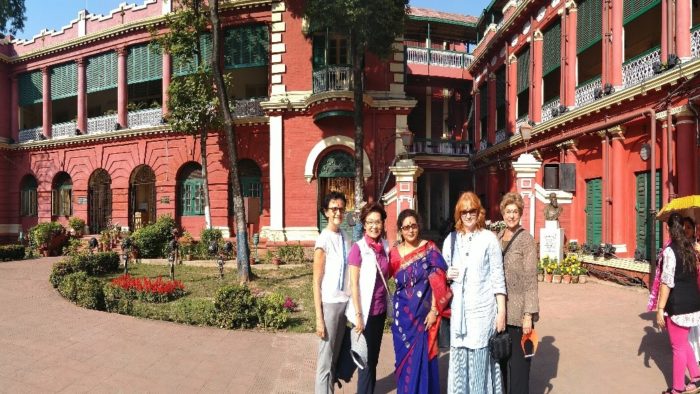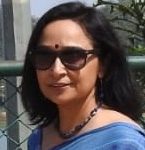Author and museum curator Anita Bose organized a trip to India for her colleagues at the National Museum, Bangkok. While these friends had helped her trace the influence of the Ramayana in South East Asia, she showed them the land of Rama itself.
Anita says the it was a “wonderful” study trip for 12 days to the Eastern part of India when they travelled almost 1,200 km to 38-39 places, experiencing over 20 different kinds of food, nine art and culture villages. “It was an exploration of India beyond the Taj, beyond Mughal or British glory. The Eastern part of India is enriched with the faith of the Bharatiya tradition.”
The trip was her brainchild. She says the idea of a tour of India came to her when she had travelled to Mexico and later when she volunteered at the National Musuem in Bangkok. “I realized that the perception among foreigners till date is that India is a country of poor people, who became civilized and enriched only because of the Mughals and British.”
She says that in her museum guide course, she could see the history of South East Asia closely associated with ancient India. “Everywhere I can see the influence of our eternal culture, but people are unaware about it. Unfortunately most of the history books don’t mention about our rich maritime trade, our ancient Vedic practice, art and craftsmanship or our eternal philosophy. For me it was so painful.”
She says when she spoke to her friends about the Devis of India, they only knew about the fearsome form of Kali and even that were misinformed. It took her five years to educate the locals in Bangkok through her guide tours, writing and discussions to make them curious about India. “As an At Homes chair and steering committee member of Bangkok I had been arranged 12 Asian cultural programmes in one year. That gave me the confidence to plan a trip to India.”
Since most people know about the Taj Mahal and the Royal life of Rajasthan, she wanted to show them the 8th century temple made of terracotta in West Bengal, the Chandraketu Garh of Bengal or Ratnagiri of Odisha, the birthplace of Vajrayana Buddhism.
The tour included her five friends from Thailand, volunteers of the National Museum of Bangkok, each of a different nationality –Beverly from the US, Tasnee from Thailand, Margaret from Switzerland, Cathy Lynch from Ireland, and Nathalie from France. The trour stretched from the Ganges to the Bay of Bengal, from plain land to forest and hills. They were moved by the Ratnagiri Udaygiri Buddhist sites, the Prasad and story of the Lord Jagannath Temple, textiles of Bengal and Odisha, terracotta temples of Bengal, the Gotipua dance, and Ramakrishna Mission’s huge service to society.
Travelogue By Anita Bose
Day 1: 15 Feb, 2020.
Dakshineswar / Belur Math/ Jorasankho Tagore House/ Swami Vivekananda’s Ancestoral House/ Flotel and Bar-B-Q. Park Street.
Once upon a time there was a group of people known as the Gangaridi, (refers to Ganga and Hridhay), who were people who lived near the Ganga and protected their culture and land from any invaders. There is little information about those brave hearts because of whom Alexander could not enter the ancient “Bongo Bhumi”.
We started our exploration the holy Ganga river. There was a brave and bright queen named Rani Rashmani who built a wonderful Kali temple on a tortoise hump like land, which is known as Kurma Pristhya, which is known to be auspicious land for devas. It was the time of the British rule and the queen was a widow and a mother of three daughters. One part of this land belonged to a European Christian while the other part was a Muslim burial ground. The Rani constructed the temple against all odds.


This temple architecture is known as Navaratna or nine diamond style. There are 12 Shiva temples and one Radha Krishna temple inside the main temple premises.
This temple is very famous for another reason – the great mystic Advaita Saint Ramakrishna Paramhamsha Dev lived here for many years and did his spiritual practice with great austerity.
In a rare form of the love of God known in Hinduism as Maha-bhava, he would worship the icon of Kali and would be overcome with ecstatic love for the deity, go into a spiritual trance and lose all consciousness of the external world. These experiences of God-intoxication because so frequent that he was relieved of his duties as temple priest but was allowed to continue living in the temple premises. During the next12 years Ramakrishna would dwelve deeper into this absolute love of the divine.
We did puja and darshan on Saturday morning, and the whole temple was filled with devotees and locals. The smell of incense sticks and flowers had created a serene atmosphere. We stood in a small queue and reached the sanctum sanctorum, offered our puja and received blessings from Mother Kali. The chiming of the bell, the chanting of Shiva stotra when worshipping Shiva Lingam and a light breeze coming from Ganges made our day speicial. We saw hundreds of people taking a holy dip in the river.
We continued our journey towards the western side of the Ganga. The next stop was Belur Math - the spiritual center of modern India. We met the senior most monk of the Ramakrishna Order who explained to us the motto of Ramakrishna Mission and Math in whole world. Atmano Mokshartham Jagat hitya cha. -Your own salvation through the service of world. My friends were here for the first time and came to know something so different in the path of Bharatiya Spiritual path.

Belur Math is also an architectural glory of mixed design, was conceptualized by Swami Vivekananda and was consequently implemented by another great monk of this order Swami Vigyanananda Ji, who was an engineer in his pre-monastic life. A beautiful temple which is a confluence of Rajasthani architecture, Buddhist cave style and even the European style in the use of Domes. This place is just beside the Ganga just like Dakshineswar. Belur Math is not only the abode of Ramakrishna Paramhamsha Dev, it also houses the temple of Holy Mother Sarada, Swami Vivekananda and Swami Brahmananda along with a magnificent, world-class museum.
Apart from the monastery, a library, an elder care hospital, Swami Vivekananda University, Palli Mangal craft center, a huge literature store and many official buildings, dining hall and a guest house are also present inside the campus. From our conversations with Assistant General Secretary Swami Bodhaswarananada we came to know about the huge welfare work they are doing around the whole world. Till date, they have 214 center all over the world. Every year almost 500 million students study in their schools, colleges and university. Thousands of rural women are getting trained in various craft fields and men are trained in vocational courses.


After taking prasad, we got a rare chance to sit inside Belur math premises after normal visiting hours. One can feel that quietness, calm and deep spiritual surroundings which is brought about by daily puja, yagna, japa, and meditation. Lots of old green trees and beautiful flowers blossom besides the tranquil sound of river Ganga. We passed few bramhacharis or orange garbed young monks on our way through the campus
After lunch we proceeded to Jorasankho Thakur Bari which is the home of Nobel Laureate Poet Rabindranath Tagore. Our car turned towards old Kolkata which is famously known as North Kolkata. So many historical events are associated with this place. Our driver Awadh ji adept at driving in the narrow lanes of north Kolkata. We entered a big red coloured building.


The ancestral home of Tagore is a red brick mansion which can be dated back to the 18th century when it was built by Prince Dwarka Nath Tagore, the poet’s grandfather. Now this has been converted into a Museum home to many books, journals, painting, photographs, crafts and sculptures, and many belongings of the Tagore family. This mansion, one of the heritage buildings of Kolkata, had started from a small house, and slowly the different wings and alleys were added to the original architecture. The architects that worked towards the building were all British and thus the architecture is largely based upon the Indo-European concept. The main attraction of the house is the west verandah attached with Poet’s room that has also been interwoven into his writings.

The mansion is built in such a way that from the rounded verandah the house dwellers can watch programs happening on the stage, in the center of the house. Tagore believed that women should also have free discussions over culture, literature, business, etc. The outlook of the Tagore family contributed to many a cultural change in Bengal Society.
When we walk in these building so many memories coming to mind, specially inside the Tagore room, the light tone of his music and seeing his work in his handwriting.
Our first day was quite splendid, Cathy remembered a few stories about Tagore and we come to our car and left with wonderful poetic memories. Next stop was the refurbished house of the most powerful philosopher, monk and reformer of the world. It was Swami Vivekananda’s ancestral home - another wonder of North Kolkata.

Swami Vivekananda’s entire childhood was this house. It used to be a ruined mansion but after 12 years of hard work it has been restored to its glorious former self, as it was in the late 19th century. We were so fortunate to do a meditation beside the sanctum sanitorium of Swamiji. My friends were very touched by the story of Swamiji’s life through the wonderful audio and vidio presentations of his life. After visiting these beautiful Bengali style architecture we met the monk on duty and conversed with him.
After a whole day wondering and exploring Kolkata it was time for a cup of nice tea. Our car moved towards the most colonial area of Kolkata. We crossed the beautiful Governer’s house, Writers’ Building, lush green field of Maidan, Eden Garden stadium and finally reached the riverside open air hotel Flotel, just beside the Ganga.


We were watching the beautiful sunset and suddenly I turned my head to the opposite side and saw another beautiful bridge on the Ganga, which we had crossed a few hours ago.

After a refreshing cup of tea overlooking the setting sun, it was time for early dinner at Park street BarBQ. We enjoyed the sumptuous north Indian thali at the 80 years old restaurant at Park Street. A day to cherish and revisit for many years to come.
(Part II will be posted shortly)





